Vizio m elevate soundbar review great soundtracks vizio m elevate soundbar review great sound effects vizio m elevate soundbar review great sound bites vizio m elevate soundbar review great sound ninja vizio m elevate soundbar review greatest vizio elevate soundbar specs vizio elevate firmware
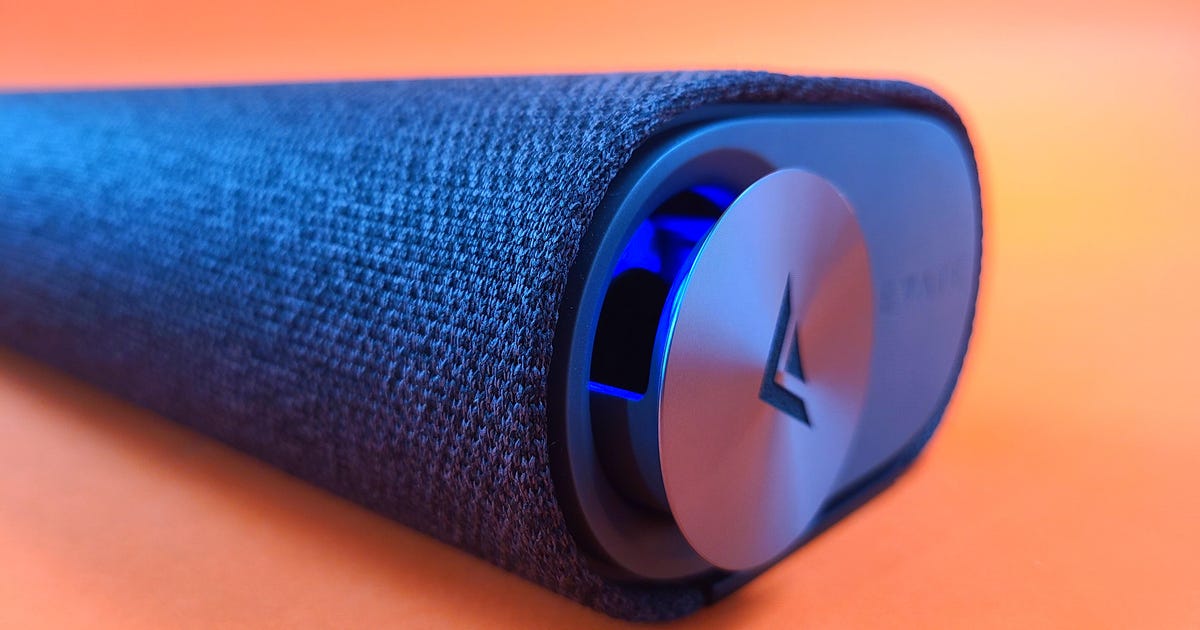
Vizio M-Elevate Soundbar Review: Great Sound, Elevated Price
Vizio made its name with value-conscious televisions, but it has cemented that reputation with a remarkable procession of soundbars. As far as sound-for-money is concerned, nothing can beat models like the V21 and M512a -- each of which is the best at their respective price points in my book. In recent years Vizio has branched out into more luxurious soundbars, beginning with the original Elevate. The follow-up, matching the M-Series TVs, is the M-Series Elevate soundbar.
Like
- Open, natural sound quality
- Plenty of bass from a small sub
- Better with movies than a single soundbar
Don't Like
- Disappointing height channels
- Changing inputs is tediously slow
- Sound too similar to much cheaper M512a
- Relatively expensive
In Vizio's naming scheme, the 'M' usually suggests a midrange product, and yet this bar still comes with a $800 price tag. It performs well, both with music and movies, and will fill a modest living space with sound. The main "issue" for the M-Elevate, though, is that it's too similar to the $500 M512a-H6 -- both in terms of functionality and sound quality. The main tie-in with the premium Elevate are the revolving end pieces for Atmos height effects, but that doesn't quite justify the extra $300.
Design
Let's get this out of the way first: The reason you're probably reading this review is because of that distinctive audio bling. Like the momma Elevate, the M-Elevate features a revolving driver at each end designed for Dolby Atmos. It works a little differently than the original version, however, as that model was able to physically revolve between stereo and Atmos mode. The pop-out height drivers of the M-Elevate can only engage when the soundbar detects Dolby Atmos or DTS:X content, not stereo. The user can change the light to one of a selection of colors -- adding customizability -- and the driver is held on by magnets in case it accidentally gets knocked. It just sticks straight back on. While the motorized LED indicator is hella cool, it's not entirely necessary.
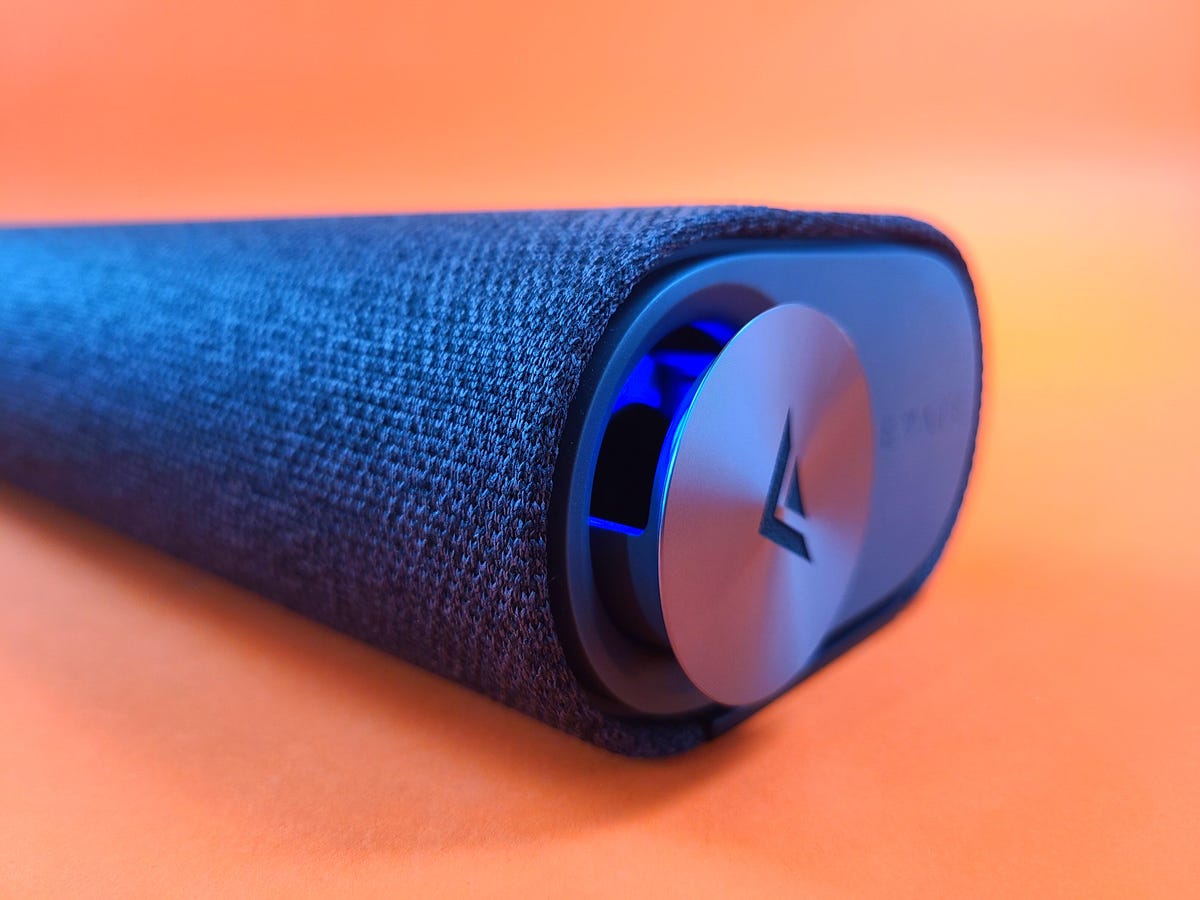
Vizio M-Elevate's height driver
Ty Pendlebury/CNETThe Vizio M512a-H6 is a surround system consisting of a main soundbar, a 6-inch subwoofer and two wired rear speakers. Like the M512a-H6, the M-Elevate is able to handle competitive DTS:X format as well as the latest HDMI eARC connectivity.
Despite being an Elevate model, the M-Elevate has more in common with the M512a-H6, both in terms of capability and in size. While the styling is different, the soundbar itself is similar to the cheaper model's bar at 41.38 inches wide, 2.6 inches high and 41.38 inches deep. The main grille, which hides three sets of mid-drivers and tweeters, is made of fabric, while the end piece that hides the two upfiring drivers is made of plastic and aluminum.
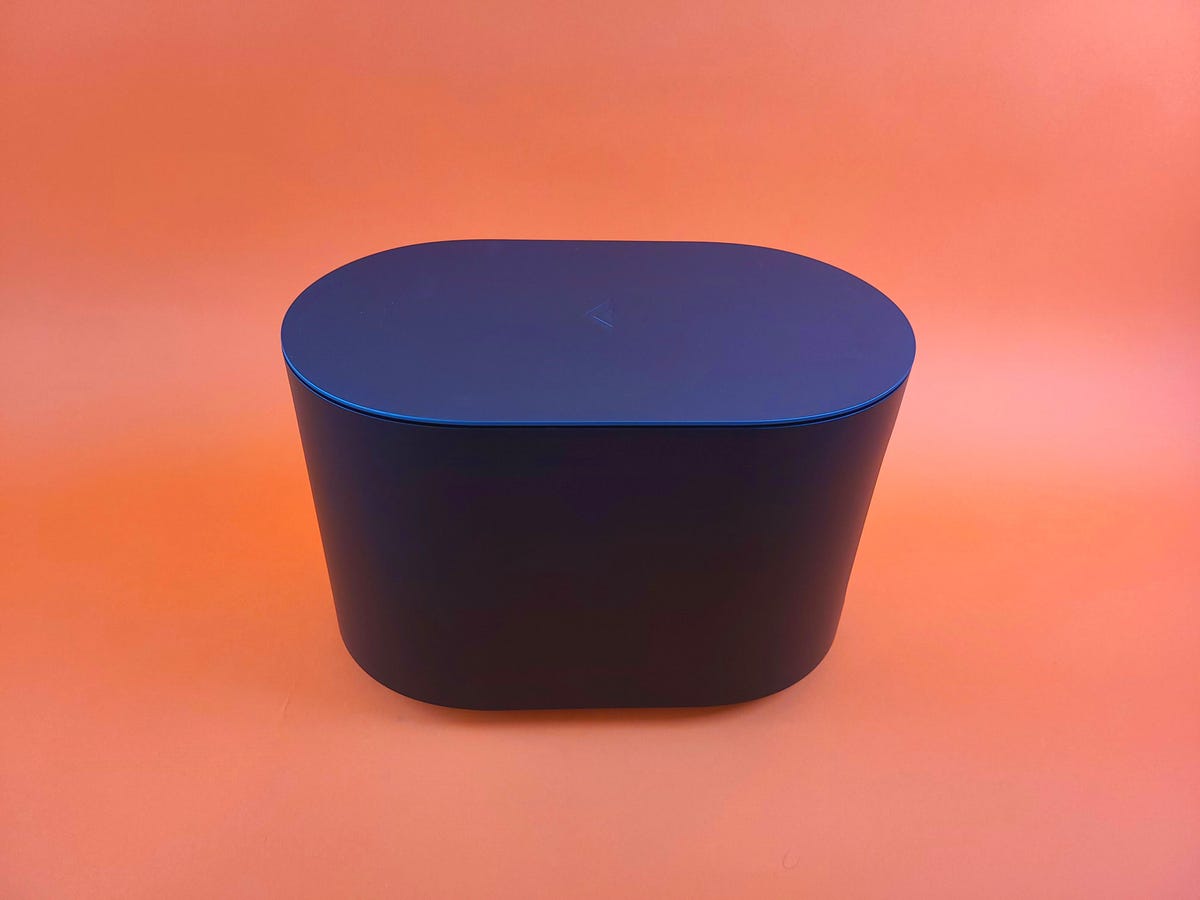
Likewise, the two systems' subwoofers each sport 6-inch drivers although the M-Elevate is contained in a slightly-more-elegant curved box. The surrounds that are physically wired to the sub via long cables are straight rears -- there are no heights here.
The M-Elevate features a selection of inputs, including HDMI in/out (with eARC), optical, USB (for WAV playback, which is a little odd) and two 3.5mm (headphone-size) analog input jacks. One of those 3.5mm connections is designed to connect a smart speaker like the Amazon Echo Dot, and the soundbar volume will mute if you issue it a command. Given that the soundbar doesn't have multiroom music like the Elevate, it's a relatively easy way to add it.
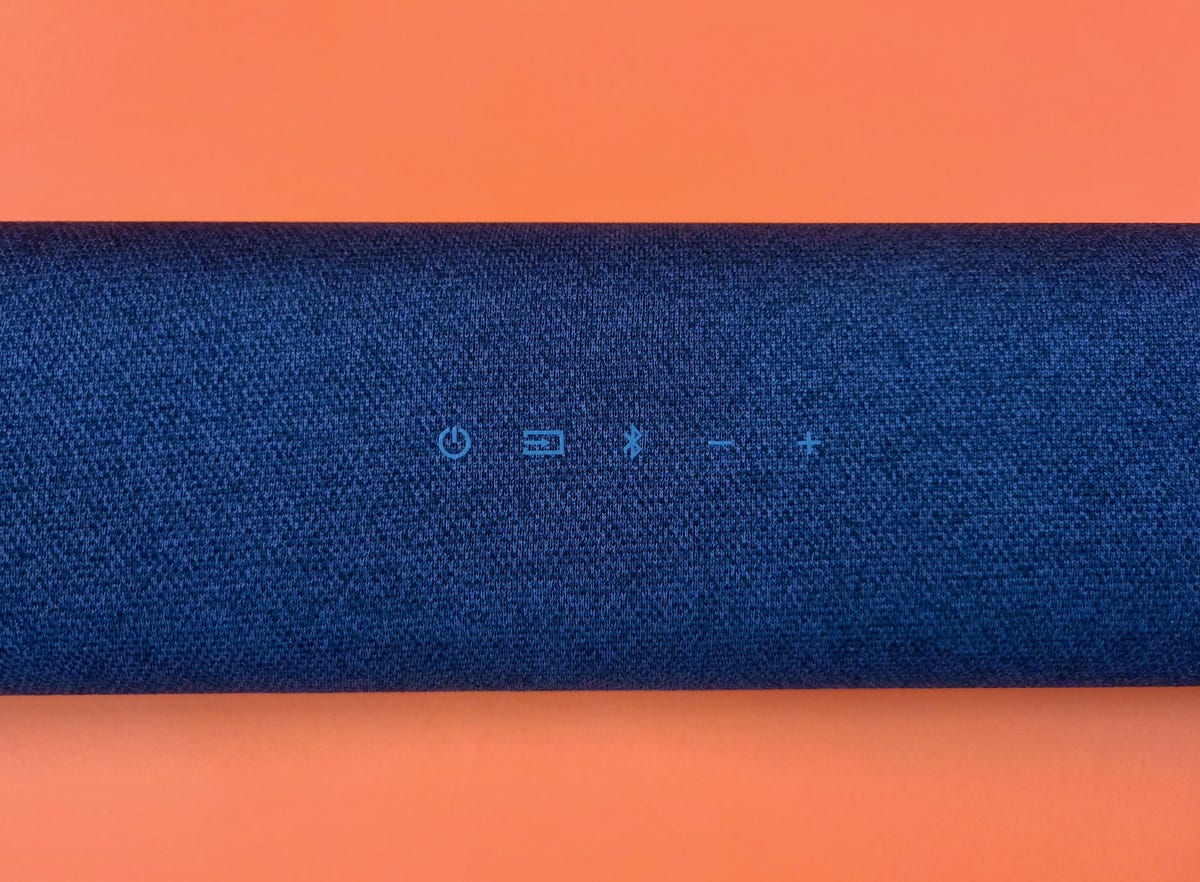
You see, like the M512a, the system's wireless connections are limited to Bluetooth. That's fine for many uses, but It's a shame that the M512 loses the Vizio Elevate's ability to stream Wi-Fi music and integrate with the Google Assistant. The $999 Elevate is still the only Vizio soundbar to offer Wi-Fi connectivity with Chromecast built in and Spotify Connect.
The system offers a number of sound modes including Movie, Music, Game and Direct, but one thing it doesn't have is a dedicated voice mode for making TV dialogue more understandable.
The top of the bar includes a limited number of controls such as power, volume, input and Bluetooth. The control is a proper wand rather than a plastic credit card, and the LCD display is used for initial setup and altering advanced settings. To adjust the volume of the height speakers is a little laborious, as you need to feed it a Dolby Atmos signal first (via a Netflix show, perhaps) or the remote will give you a "Not Available" message.
One other issue I had with the remote is that changing inputs could be very slow -- if you took less than two seconds to change the input, the readout on the remote and the soundbar would go out of sync. This would necessitate putting my hand over the remote and cycling it back to the input that matched the bar.
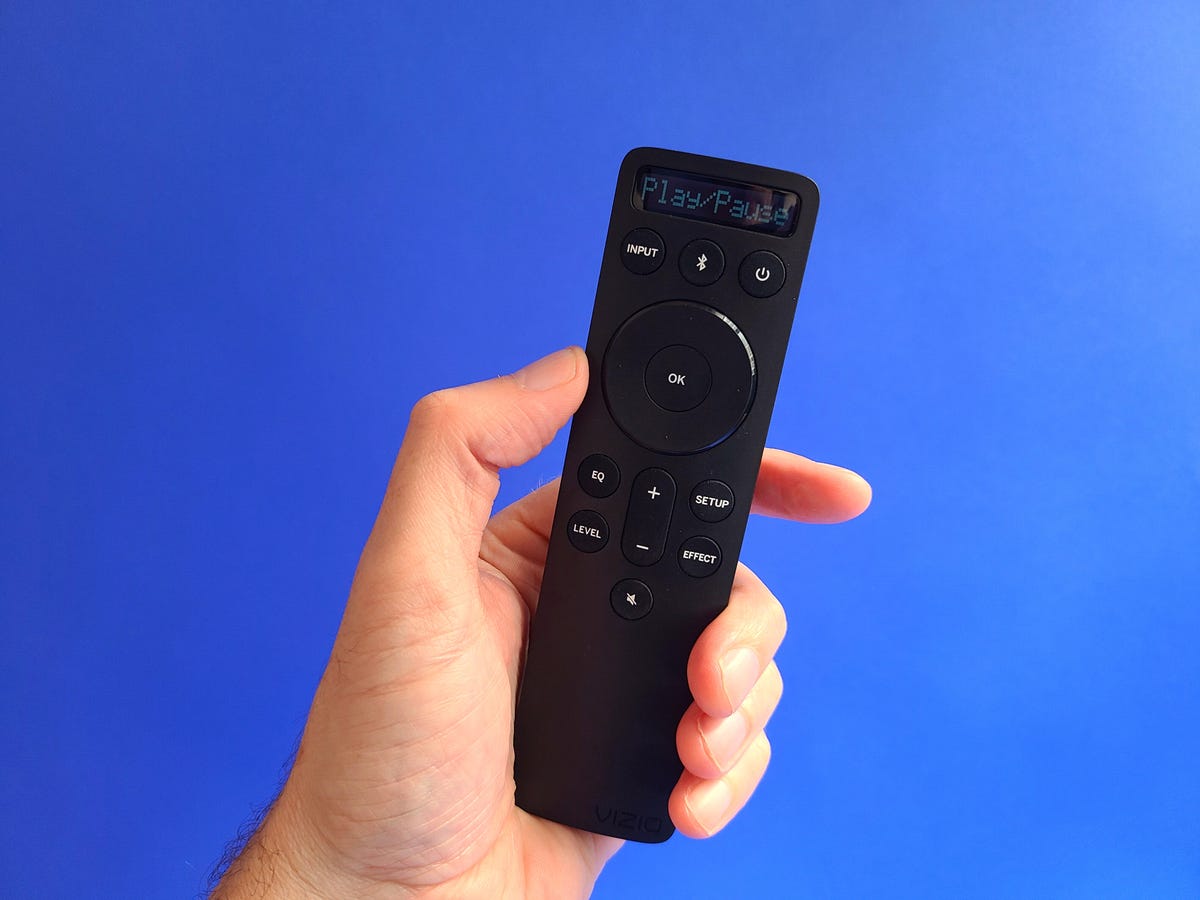
How does it sound?
If you're paying more than $200 for a soundbar, you want to be sure it can truly act as a replacement for an AV receiver, and this means not only its ability to act as a switch, but to play music. I began my review with a couple of folk-centric Australian bands -- Dead Can Dance and Grand Salvo -- and began ratcheting up the tension after that. When I heard the first notes of Dead Can Dance's Yulunga I was immediately struck by how natural music sounded coming out of the soundbar. There was a lack of honkiness or nasal qualities, and I couldn't tell that the sound was coming out of a plastic tube in front of the TV. Lisa Gerrard's voice appropriately sounded huge and the room became a concert hall, with the deep bass of the percussion realistically rendered.
Next, Grand Salvo and his story of a lifelong friendship cut short in "Field of Flowers." The song starts with a gentle guitar strum and Paddy Mann's weary vocals, and the Vizio let the story play out. Yet, it was only during the chorus where the sound became a little pushy with the group vocals. Conversely, the price-comparable Sonos Arc was able to handle the same dynamic shifts but able to render the choir more agreeably.
After listening to a selection of different music I moved to surround sound and the lobby scene from The Matrix. I compared the M-Elevate against its M512a label-mate and found that the two shared a very similar sound -- not surprising given the soundtrack's reliance on deep bass and the similarity of the two subs.
After switching to the Sonos Arc I felt that Vizio's rival offered a better level of detail. For example, as the soldiers assemble in the lobby to take on Neo and Trinity one of them shouts "Freeze." The sound hung in the air on the Arc, and when the bullets started flying the Sonos also offered a wraparound effect of the Arc that wasn't matched by the M-Elevate. The Vizio was more subtle in playback during this scene but the Arc was more fun, but where the Arc couldn't match the M-Elevate was for deep bass due to the dedicated sub.
The big test with a soundbar like this is "How does it sound with Dolby Atmos," and I found the answers to be a little disappointing for an $800 surround setup. While the M-Elevate was again able to provide true surround with the war epic 1917, and therefore gaining an advantage over the Arc, the Vizio's ability to provide height effects was limited.
Sadly I was never able to get enough volume out of the M-Elevate's height drivers -- even at maximum it couldn't match either the M512a or the Arc for convincing overhead sounds. The CNET testing room has a 15 foot ceiling and the M-Elevate wasn't powerful enough to bounce sounds off it, though it was a little more successful with a 10 foot one. This isn't a problem for the less fancy M512a.
To illustrate the differences among the three soundbars, I listened to the opening scene of Mad Max: Fury Road and found that both the Sonos Arc and the Vizio M512a were able to project high and provide a true bubble of sound. Though the surrounds did help with immersion, the M-Elevate was only able to make the ethereal voices sound like they were coming from the screen.
Should you buy it?
Vizio's main issue is that it didn't really need to fill the space between the M512a and the Elevate. The M-Elevate doesn't add all that much for the extra $300, though it works well in almost every regard but Dolby Atmos playback. As a result, the M-Elevate's main competitors are the two soundbars that bookend it: The M512a offers better sound and a better price while the Elevate offers a much bigger package with more useful features for $200 more.
If you don't mind filling your room with boxes, the M-Elevate does offer a compelling alternative to the similarly priced Sonos Arc, and it sounds better with movies, too. Yet, that said, you should probably save some money and get the M512a instead.
Source
Blog Archive
-
▼
2022
(240)
-
▼
October
(83)
- Best E Ink Tablets For 2022: Note-Taking Solutions...
- Vizio M-Elevate Soundbar Review: Great Sound, Elev...
- Bridgerton Was The Biggest Thing On Netflix Last W...
- Apple Watch SE Sale: Save $60 Ahead Of Cyber Monday
- Rev Up For A Live-Action Hot Wheels Movie From J.J...
- Samsung Summer Sale: Up To $800 Off Appliances And...
- Paramount Plus, Showtime Now Available In A Single...
- Lenovo Staff Loses Company-issued Laptop... And Co...
- Who Is WhatsApp Co-founder And CEO Jan Koum?
- 2022 Honda Pilot Sport Becomes New Base Trim, Resu...
- Uber Will Rent Teslas To Its Drivers Through New H...
- Oppo Find X5 Pro: Five Reasons This Flagship Andro...
- Facebook Is Shutting Down Its Facial Recognition S...
- All The Google Docs Features From My Wish List Tha...
- Netflix Rejigging Squid Game To Cut Phone Number A...
- Best Mattresses For Kids In 2022
- Pixel 6 Pro Review: Google's Flagship Is Still A T...
- High-end Drip Coffee Makers That Take Brewing Seri...
- Canva: The Poster Child Of DIY Graphic Design
- Halloween PlayStation, Xbox And Switch Game Sale
- How To Stream Netflix's Epic Kanye West Doc Today,...
- Facebook's Global Head Of Safety Hasn't Fully Read...
- Hindsight Asks Players To Confront Loss, Grief And...
- Xiaomi Redmi Note 5 Is An Android Phone For The Ma...
- 'All The Old Knives' Review: Lacklustre Chris Pine...
- Google Updates In-App Billing Rules To Allow Rival...
- Best Wi-Fi 6 Routers Of 2022
- Pac-Man Live-Action Film In Development
- The Trick To Getting A Gym Membership For Practica...
- Microsoft Store On Windows To Allow Third-party St...
- 'Nope' Isn't Streaming Yet, Sorry (but Here's When...
- Ring Alarm Pro Review: A Giant Leap For Home Security
- Remember Chumby? Cute Touchscreen Gadget Returns F...
- Streaming Means You'll Never Own Your Favorite Mov...
- Best Drones For 2022
- IPadOS: 5 Best New Security And Privacy Features F...
- Acer Reveals Chromebooks, Eco-friendly Laptops, Ga...
- 2023 Kia Sportage Hybrid Review: Grow Up, Glow Up
- Forget The Galaxy S22 And Get An S21: Main Differe...
- 9 Great Reads From CNET This Week: PS5, Apple Watc...
- The Trick To Finding Free Wi-Fi Anywhere In The World
- How To Turn An IPad Into A Second Display For Your...
- Halloween 2019: Last-minute Costumes You Can Get O...
- Robinhood Starts Rolling Out Beta Version Of Crypt...
- WhatsApp Is The World's Most Popular Messaging App...
- 2022 Kia Carnival First Drive Review: A Luxurious ...
- NASA And SpaceX Prep Halloween Launch For Crew-3 T...
- $55,000 Honda Civic Si FE1 Is An Accessible Turnke...
- Forest Bathing: The Free Cure For Stress And Anxiety?
- How To Get Your New Backyard Ready For Hosting
- Get The Motorola One 5G Ace For $30 When You Sign ...
- Best USB-C Monitor Deals: Get A 24-Inch FHD Displa...
- Ransomware Cost US Schools $3.56 Billion In 2021, ...
- DJI Osmo Mobile 2 Will Be The Phone Camera Stabili...
- AMD Previews CPUs For Cheap Laptops, Flagship Gami...
- Instant Pot's Vortex Plus Proves 2019 Really Is Th...
- Don't Have AC? Try Putting Your Socks In The Freezer
- 2022 Bentley Flying Spur Hybrid Review: Your Milea...
- Xiaomi Mi Mix 3: Release Date, Price, Specs, Four ...
- Hailee Steinfeld Finally Confirms She's In The New...
- $10,000 Or $50,000 Student Loan Forgiveness: Could...
- New Gadget Warns You When You Smell Bad
- What It's Really Like At 'Hacker Summer Camp'
- When Local Newspapers Fold, Polarization Rises. He...
- Xiaomi Redmi 3 Review: Xiaomi's Redmi 3 Is Pretty ...
- Unplug These Appliances To Save $100 Each Year
- Apple's IOS 15.2 Update: How To Download, New Feat...
- World's Oldest Living Dog Is A Toy Fox Terrier Tha...
- SpaceX's Starlink Satellite Broadband Is Coming To...
- LG's Star Wars C2 OLED TV Goes On Sale
- How To Fix Netflix Error Code M7111-5059 If You Ha...
- The Best Sci-Fi Movies On Netflix You Absolutely N...
- A Gadget To Test For Food Allergies? Not A Piece O...
- Pokemon Sword And Shield Players Can Get A Shiny G...
- San Diego Comic-Con 2022 Highlights: New Avengers ...
- How To Adjust To The End Of Daylight Saving Time
- 'House Of The Dragon' Small Council: What Do Those...
- Deleting Your Twitter? Here's How To Archive Your ...
- Windows 11 Review: Microsoft's Subtle Changes Make...
- 2022 Honda Civic Sedan, Hatchback Designs Show Up ...
- WWE WrestleMania 38 Sunday Results: Reigns Wins, F...
- I Bonds Fight Inflation With A 9.62% Return: How L...
- Rhythm Action Game Thumper: Pocket Edition Now Ava...
-
▼
October
(83)
Total Pageviews
Search This Blog
Popular Posts
-
Cartao de credito de tester, gerador de cartao de credito de portugal, santander cartao de credito desbloquear, cartao de credito de alumini...
-
Ukuran name tag yoyo stroller, ukuran name tag yo yo tricks, ukuran name tag yoyo games, ukuran name tag yoyo loach, ukuran name tag yoyo bu...
-
Ukuran f4 sama dengan a4 paper, ukuran f4 sama dengan a4 size, ukuran f4 sama dengan a4a, ukuran f4 sama dengan a4 apparel, ukuran f4 sama d...
